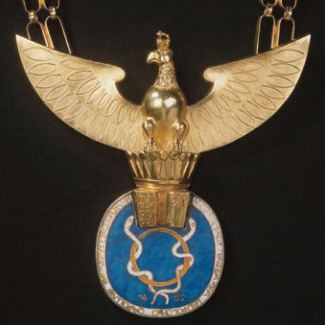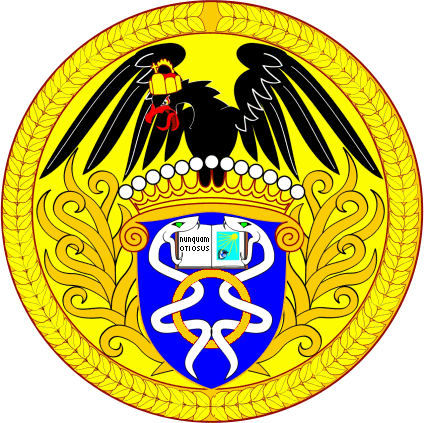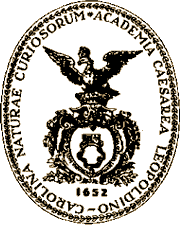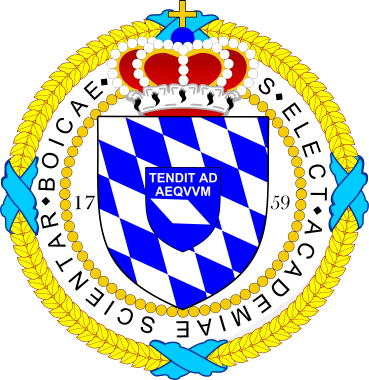In 1652, the Leopoldina was founded in the free Imperial City
of Schweinfurt by four prominent physicians
interested in Natural Sciences,
including Johann Lorenz Bausch (1605-1665)
who became its first president. It was originally
called Academia Naturae Curiosorum.
In 1670, the Academy began the publication of a journal, entitled
Ephemeriden which was dedicated to the
Holy
Roman Emperor Leopold I (1640-1705)
who had been elected Emperor at Frankfurt in 1658
and was known as a patron of the arts and sciences.
In 1677, the Academy had its official name changed to
Romani Imperii Academia Naturae Curiosorum.
In 1687, it became
Sacri Romani Imperii Academia Caesareo Leopoldina Naturae Curiosorum
as Leopold I vested it with extended privileges,
including the rights to award academic degrees and to publish scientific research without censorship.
The name which appears around the seal currently sported by the Leopoldina is:
Academia Caesarea Leopoldino-Carolina Naturae Curiosorum.
The Academy thus appears dedicated to two emperors (Leopold and Carl)
because its privileges were confirmed in 1742 by
Charles VII.
However, the Academy is universally known simply as Leopoldina.
The latter patron is all but forgotten, although the full name
Imperial Leopoldina-Carolina German Academy of Natural Scientists
was sometimes used in English before 1990.
For a long time, the Leopoldina was merely based wherever its current president
happened to reside... Therefore, it had many successive homes:
Schweinfurt, Nuremberg, Augsburg, Altdorf, Erfurt, Halle (1745-1769),
Nuremberg again, Erlangen, Bonn, Breslau, Jena and Dresden. In 1878,
it settled permanently in Halle an der Saale,
where the Academy Library would be built in 1904, which still serves as its headquarters.

Chain of Office,
by Karl Müller and Renate Greff (1956/1957).
|
|
Until 2007, the full name of the Academy was
German
Academy of Sciences Leopoldina
(translated from its German name:
Deutsche
Akademie der Naturforscher Leopoldina).
Its uninterrupted existence since 1652 was reaffirmed in the new statutes
which were adopted in 1991 (after the reunification
of Germany in 1990).
The Leopoldina managed to uphold its status as an
all-German institution against the will of the East-German communist state
(GDR)
while it lasted (from 1949 to 1990).
At first, the Academy did that by holding its
conventions alternately in its home at Halle (East Germany)
and in its historical birthplace at Schweinfurt (West Germany).
Even when the Cold War and the erection of the
Berlin Wall
in 1961 made that an impractical proposition, the
Leopoldina did somehow survive as an Imperial institution...
On November 16, 2007,
German Science Minister, Annette Schavan (CDU) announced officially that the Leopoldina would take on
the vacant rôle of a national science academy for unified Germany.
It thus became an advisory body to the German
government on scientific matters, under the official name
Deutsche
Akademie der Wissenschaften (German Academy of Sciences).
Curiously, the new name would broaden the scope of the Academy, since the German
word Wissenshatfen encompasses both natural sciences
and humanities, although the Leopoldina has no traditional competence in the latter.
Regardless of its new name and status, its heritage makes the Leopoldina
the oldest of the three extant major European scientific
academies founded in the middle of the 17th Century.
The other two are the Royal Society of London (1660) and
the French Académie des Sciences (1666).
Although the Accademia dei Lincei
(to which Galileo
belonged) was founded half a century before the Leopoldina (in 1603)
it cannot claim the same uninterrupted existence...
Actually, that Italian Academy has two modern reincarnations:
-
The Pontifical Academy of Sciences is the modern name
given in 1936 to the Accademia Pontificia dei Nuovi Lincei
which Pope Pius IX had revived in 1847
(following an 1838 proposal of Gregory XVI).
- The
Accademia Nazionale dei Lincei
(National Lincean Academy) is a secular spinoff of the previous one.
It was created in 1870 under the name of
Reale Accademia dei Lincei
(Royal Lincean Academy).
The Leopoldina Academy itself served as the model for other German academies
with a more regional scope, including the
Bavarian
Academy of Sciences and Humanities, founded in 1759:





